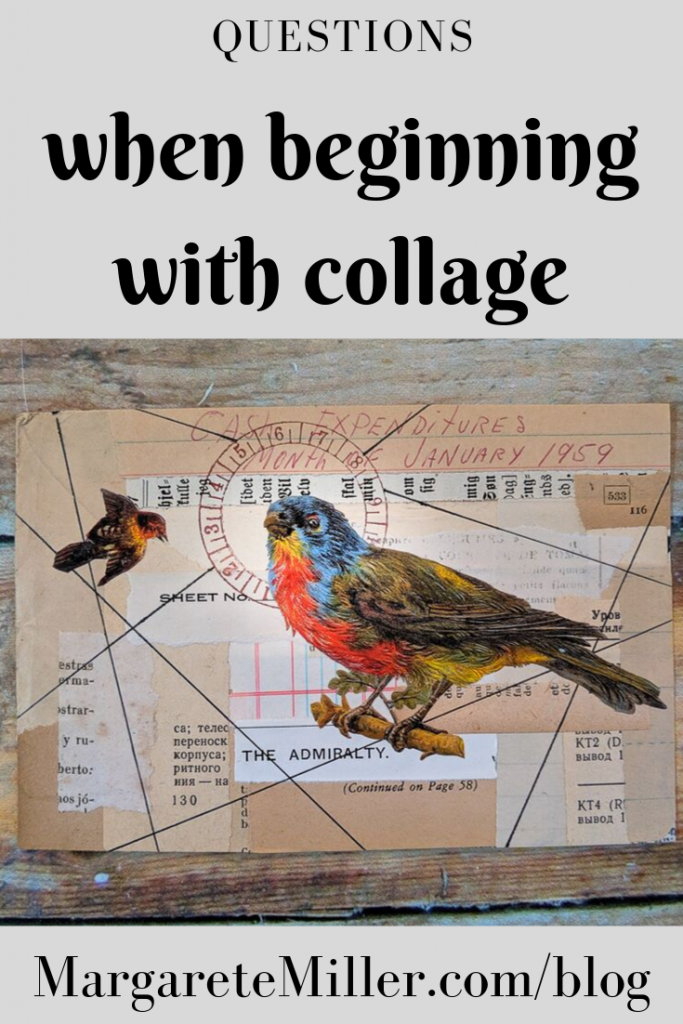Questions when beginning with collage art
Often, the hardest part of doing collage art is beginning. Those who are just starting out often have lots of questions and concerns:
- “I don’t know where to begin.”
- “What if I’m doing it wrong?”
- “Aren’t there some rules I should be following?”
- “What if I don’t like what I make?”
- “What if no one likes what I make?”
Let’s go through these one by one.

“I don’t know where to begin.”
If you aren’t sure what to create, or how to create a layout you can use the weekly assignments that I post here to help you get going. Here are some suggestions:
1. Read the assignment and gather your pieces.
2. Gather a few extra options of the same prompt. For example, if one of your prompts is “tea bag cover” and you drink different kinds of teas, collect a few different ones--you never know what’s going to work better in your collage until you start playing with the pieces together.
3. Choose a gluebook to make your collage.
4. Determine if you'd like to use a piece of pattern paper or book page as a background or part of a background.
5. Lay your pieces on your workspace, and start to add them one by one your page, without glue. Move them around the page, perhaps swap out pieces if you aren’t happy with a combination.
--step away for some minutes, hours, even days to give your collage some breathing room--
6. Looking at the overall composition of your layout, determine if you like how it looks and want to begin gluing things down, or it you’d like to add something else, such as a piece of pattern paper or a piece of washi tape. You may also make that decision once everything is glued down.
7. Once everything is glued down, see if you want to add anything else, such as a rubber stamping or another small paper scrap. If not, you're done.
“What if I’m doing it wrong?”
The great thing about collage art is that you can gather your elements, and move them around on your page before deciding where you want to glue something down. This little fact is wonderful, particularly if you are short on time and just have a few minutes here or there, throughout your day to make some art. Lay some papers down and come back to it, moving things around, taking away what doesn’t look right and adding something else. Sometimes I have a collage laying out on an out-of-the-way table for several days until I think it looks right.
“Aren’t there some rules I should be following?”
Rules exist, but of course it’s up to the individual to follow them or not. In composing something visual, there is “the rule of thirds”, which is really more of a guideline. Imagine drawing tic-tac-toe lines across your page so that you have 9 equal quadrants. The guideline proposes that the more important elements be placed along those lines or where they intersect. In other words, don’t have your most important element in the very center. Following this “rule” is up to you. Experiment and see if it works for you. One strong recommendation I have, rather than a rule, is to know what styles you like. It’s helpful knowing what type of collage art you like and what you’d like to emulate. Pinterest or Instagram are good places to check periodically to get new inspiration.
“What if I don’t like what I make?”
The inner critic is sometimes our worst enemy. If you have doubts about your own abilities and are afraid to try making a collage, ask yourself this: can you dress yourself in the morning with clothes that more or less coordinate? Can you walk into a room in someone’s home and see how the flooring coordinates with the wall paint, with the furniture, and light fixtures (or how it doesn’t)? If you said yes to those things, then you can take some random pieces of paper and make them work together using washi tape and maybe some pattern paper. There’s logic in collage art. The best thing is that the logic is yours. You get to decide.
“What if no one likes what I make?”
Are you making art for someone else or are you making it for yourself? Though we all like the idea of sharing what we make with a receptive audience, it’s important to protect yourself from negativity, and sometimes negativity can come from family or the people around you. Begin with making art for yourself. After that, look for a supportive environment where you can share your art. Facebook, for example, has lots of art groups where people share their art and comment on others. My own group is Vintage Gluebooks and Pages, where we share collage art done in a vintage style. Make the decision that you are making art for yourself and that you have nothing to prove. Read the words in the illustration below and let them sink in. The art you make is for YOU.

I've posted this illustration in my Getting Started with Collage Art blog post, and it's worth posting it here again because they are words that can really help you focus on your goals and the way you think about your art and its purpose.
I hope this helps. Let me know if there are other concerns I might have missed.


